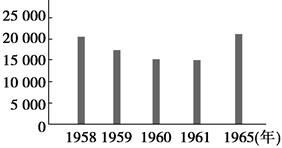下面是1958~1965年全国粮食产量示意图(单位:万吨),造成以下数据变化的主要原因不包( )。

A.农村工作中的“左”倾错误
B.“大跃进”和“人民公社化”运动
C.对国民经济实行“调整、巩固、充实、提高”方针
D.实行“以阶级斗争为纲”的错误方针
答案:D
“以阶级斗争为纲”的错误方针是在“ * * ”时期实行的,与题中时间“1958~1965年”不符。
下面是1958~1965年全国粮食产量示意图(单位:万吨),造成以下数据变化的主要原因不包( )。

A.农村工作中的“左”倾错误
B.“大跃进”和“人民公社化”运动
C.对国民经济实行“调整、巩固、充实、提高”方针
D.实行“以阶级斗争为纲”的错误方针
答案:D
“以阶级斗争为纲”的错误方针是在“ * * ”时期实行的,与题中时间“1958~1965年”不符。